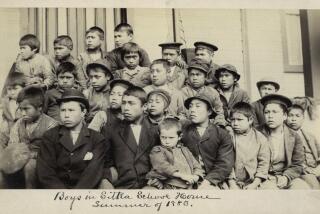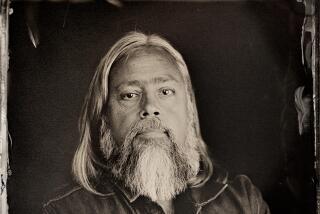Turner’s Year of ‘Native Americans’ : Television: Sunday’s ‘Geronimo’ kicks off a variety of programming with indigenous people as the unifying theme.
No one will ever accuse Ted Turner of minimalism.
December is kickoff month for Turner Broadcasting System Inc.’s company-wide cable television blitz designed to acutely sharpen the focus on America’s indigenous people.
“The Native Americans. Behind the Legends. Beyond the Myths” will roll on for more than a year, starting with the 5 p.m. Sunday arrival of “Geronimo,” the first of three made-for-Turner Network Television (TNT) movies with Native American themes and casts. “The Broken Chain” follows on Dec. 12 and “Lakota Woman” next year. All will get multiple showings.
Coming to TBS in October, 1994, meanwhile, is a six-hour documentary on Native Americans, and CNN is preparing a 20-part series on the same topic for launching late next year.
What are some of the “legends” and “myths” that the Turner project can be expected to address? Thanks in part to the entertainment industry, they’ve endured for generations. Here, for example, are scenes from “They Died With Their Boots On”:
Sitting around a campfire with other braves, a Native American grunts, “Ugh!” A comrade responds, “Ugh!”
Heroically fighting off attacking Native Americans at Little Big Horn, a U.S. soldier screams, “You yellow bellies!”
These words and attitudes--from Raoul Walsh’s 1941 film starring Errol Flynn as a dashing and visionary Gen. George Custer, who dies a glorious death with his brave troops--were routine for Westerns of that age and even much later. They largely portrayed Native Americans as faceless, one-dimensional, white-slaughtering savages who were somehow evil and bloodthirsty for opposing occupation.
These are the movies that many of us grew up on, movies that helped shape our odd notions about how the West was won, movies that have gained an extended life and audience through television (this one aired recently on the Movie Channel).
They’re an archive of the critical role that Native Americans have played in film mythology about this nation’s evolution. To justify the land-grabbing of settlers and atrocities of soldiers, Native Americans had to be diminished and demonized. For years and years, that’s exactly what happened in movie Westerns that fictionalized history as a way of rationalizing the usurping of native lands.
Proving that even entertainment moguls are occasionally educable, however, a backlash gradually set in. The result was an era in which the “in” Indian was a noble Indian--call it overcompensation--and its residue still lingers.
For all its stunning sights and other attributes, for example, even the Oscar-winning “Dances With Wolves” set Plains Indians on a very tall pedestal, despite the appearances of a few brutal Pawnee. And on a much smaller scale, nobility is the predominant quality of Native Americans in the CBS Western series “Dr. Quinn, Medicine Woman,” in contrast with the multifaceted, more fully developed contemporary Native Americans of that network’s “Northern Exposure.”
Just as Westerns appear to be making a modest comeback in cinema and TV, Geronimo--the storied Apache chief who died in 1909--is the inexplicably “in” Indian of the 1993 holiday season, more popular even than Frosty the Snowman. In addition to TNT’s movie, he’s the center of a Dec. 16 segment of the Arts & Entertainment network’s documentary series “The Real West.” And coming Dec. 10 (following 1940 and 1962 film treatments) is “Geronimo” the theatrical movie, with Wes Studi (who played Magua in “Last of the Mohicans” and the fiercest of the Pawnee warriors in “Dances With Wolves”) in the title role. Yet non-Indian characters are also the focus of this “Geronimo,” with a gooey trailer for the movie showing a sensitive Jason Patric telling an attentive Studi that he’s just a man “like you.”
*
There’s none of that through-white-eyes stuff in TNT’s very gory, but very interesting and intelligent “Geronimo.” Written by J.T. Allen and directed by Roger Young, it’s told solely from the perspective of the Apache leader himself, known as Goyahkla before earning fame as a great warrior among this Southwestern people who were split into bands that had tenaciously battled Spaniards for centuries.
We first meet him in 1905 as an old man (played by Jimmy Herman). Despite being confined in Florida as a virtual prisoner of war, he’s “Mr. Geronimo” to whites, a celebrity artifact wrapped in his own legend while selling autographs for $5 and wearing a regular suit of clothes for a meeting with President Teddy Roosevelt.
Then the flashback to Geronimo the teen-ager (Ryan Black), a resourceful horse thief. Then to Geronimo the vengeful mature man (Joseph Runningfox), radicalized when Mexican soldiers engage in the unprovoked massacre and scalping of unarmed Apache women and children, including his own wife and child. His second wife will later die in a similar unprovoked raid (and scalping) by the U.S. cavalry.
The story never provides context for the Mexican Army’s anti-Apache violence (these slaughtering soldiers make the cruel and racist U.S. cavalry in “Dances With Wolves” look like Boy Scouts). “Geronimo” does a better job of explaining the Apache-U.S. conflict and the dishonorable motives behind the government’s exile of these Native Americans to miserable reservations. Moreover, although the absence of native language (whites and Indians speak virtually the same brand of English) costs “Geronimo” texture, its dialogue is never stiff or stilted. And even though this is largely an affectionate take on Geronimo, his flaws are not ignored.
Both “Geronimo” and “The Broken Chain”--in which various Iroquois nations are tested during the Revolutionary War--are a good way to spend two hours. But the TNT network is not always this enlightened about Native Americans.
Wednesday night, for example, it telecast “The 7th Cavalry,” a 1956 movie that ended with hordes of Sioux about to attack the Little Bighorn burial detail. But they were stymied--stopped in their tracks--by “the spirit of Custer’s horse.”
Ugh, indeed.
More to Read
The complete guide to home viewing
Get Screen Gab for everything about the TV shows and streaming movies everyone’s talking about.
You may occasionally receive promotional content from the Los Angeles Times.






